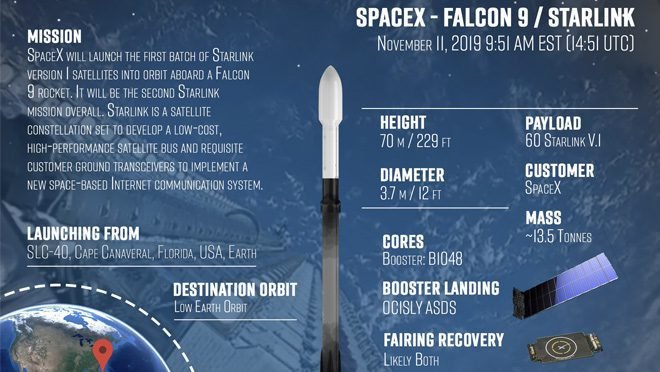SpaceX is all set to launch a Falcon 9 rocket with 60 Starlink satellites on November 19, 2019, from Florida’s launch pads. The mission will carry the first group of operational Starlink satellites to orbit. After launch, the first stage of SpaceX Falcon 9 Starlink satellites will attempt a propulsive landing on Of Course I Still Love You, a drone ship.
The first stage of this mission successfully completed its pre-launch static fire test on November 5, 2019. The fairing parts of the satellites will be reused on the Starlink L1. SpaceX has added a new and second fairing recovery ship to their fleet, GO Ms. Chief which will support the first Starlink L1 mission.

SpaceX 60 Starlink satellites, as tweeted by Elon Musk, are ready for its Low Earth Orbit. After a long hiatus of 6 months, the Starlink L1 satellites will be the first group of satellites for SpaceX’s satellite internet constellation. SpaceX in a tweet mentioned that the operational satellites will be completely destroyed once it re-entered the Earth’s atmosphere.
However, 5% of a Starlink tet satellite’s components are likely to survive the impact of re-entry. The next Starlink L1 mission is going to be the heaviest one too since it will carry the total payload of 15,600 kgs. The satellites will be deployed into a 280 km orbit following SpaceX’s acquirement of a Special Temporal Authority (STA) given to them by the Federal Communications Commission (FCC).
After the launch, SpaceX will try to establish contact with the other satellites to decide their eventual fate. If any satellite does not function properly, those will be left in the 280 km orbit to naturally deorbit.
However, if the satellites are working and are fully functioning, will orbit to 350 km to drift to their own orbit planes to ascent up to their operational altitude of 550 km. After the launch of the Starlink L1, SpaceX will shift its attention towards the CRS-19 Cargo Dragon mission to the International Space Station.




